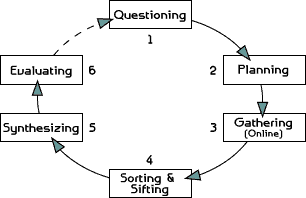The Research Cycle


Most of you have probably done some form of “research” in the past. Students often learn to do “research papers” by collecting information, copying some of it down, and then rewriting it. But research, “documented analysis” is really about asking your own questions about a topic, looking for potential answers to those questions through information gathering and then analyzing the information to decide which pieces of it answer the questions you have about the topic. The end product will be some form of reporting where you present the information which offers and answer to your question.
The way we do this is called The Research Cycle. I want you to think of yourselves as INFOTECTIVES – Detectives of information. A detective looks through all the potential clues and decides which clues pertain to the mystery, and which are merely clouding the solution.
Information + Detective =

Infotective
But what’s INSIGHT?
INSIGHT – An understanding of relationships that sheds light on or helps solve a problem.
That’s the whole idea of doing the research in the first place: to gain INSIGHT into a topic. Real insight means you have found hard answers to your questions. You should be seeking to understand the relationship between pieces of information in a way that answers the questions you have asked in step one. Right? Right.
Take a look at this flow chart as a way to visualize what you are going to do:

The Research Cycle: From Question to Insight
Let’s look at the steps again:
1) QUESTIONING
2) PLANNING
3) GATHERING
4) SORTING & SIFTING
5) SYNTHESIZING
6) EVALUATING
7) REPORTING
1) QUESTIONING: In the past, students have been asked to “go find out about” a topic. “Go find out about” WWII, or Connecticut, or Global Warming, or The Grand Canyon. Students would go to the encyclopedia and move words from one book, to their paper, changing a few here and there. Today, with the World Wide Web and the cutting and pasting technology of word processors, there is a mountain of information readily available on any topic and the ease of becoming a “word mover” makes the old ways of doing “research papers” practically useless. That’s why I want you to COME UP WITH YOUR OWN QUESTIONS within the topic you are assigned. It can be a simple question, but one you feel should be answered in a discussion about your topic. So instead of researching “The Holocaust” you would be focusing on answers to a question like “Why didn't the Jews fight back against the Nazis?” or “How did the Jews fight back against the Nazis during The Holocaust?” or “Is it fair to compare The Holocaust to other incidents of racial or ethnic oppression?” Now you are looking for targeted information that will yield specific results.
2) PLANNING: After you have established a question and now has some direction, you must plan out exactly where you will be finding your information. Your sources should be reliable. Remember, the World Wide Web is filled with misinformation. Contrary to what you may believe, Wikipedia is NOT a reliable source for information. Mrs. Jenkins and I will help to guide you toward reliable sources for your information. This is what we call Information Mediation. Information is now so readily available, we need trained professionals to help us focus our efforts. Librarians are experts in this field. That’s what they do. Smart infotectives use them as an extremely valuable resource. You will also be making a plan as to how you will store the information you gather. We will be using folders and index cards.
3) GATHERING: If your planning has been thorough and effective (it will be) you will hit the ground running when it comes time to gather information. You will have four or five people in your group to scan information for relevance to your question. It’s pointless to collect 600 pieces of information about child abuse – you need to gather pieces of information that are USEFUL in coming to some INSIGHT (answers) to your questions. Each piece of information should be collected/recorded carefully, with a citation of exactly where you got the information. Listing your sources is essential for two important reasons: so you can return to the source yourself and to allow your readers to return to the source if they want to verify what you have reported. This makes your research valuable – you will be able to prove it is based on hard evidence!
4) SORTING & SIFTING: This is an extremely important part of the research cycle. You must pick through the information and narrow it down to the MOST VALUABLE pieces. It can be tempting to simply throw a bunch of information and statistics out there and hope some of it will stick and prove your point. This will only serve to confuse you and turn off the people you are reporting to. Instead, you must carefully and skillfully zoom in on the pieces of information that will BEST serve your purpose. Everything else gets thrown away.
5) SYNTHESIZING: This is where you take all your seemingly disconnected pieces of information and begin arranging them in different ways until a picture begins to form in your mind – kind of like a jigsaw puzzle. You should be moving things here and there and seeing what takes shape. You may already start getting insights to your questions, and you may already start to realize that you are going to need more information about one particular aspect. This is where your light bulb should start to come on and you begin to see where you are going with this research. You can see an outline of the final product.
6) EVALUATING: This is the “Information Harvest” where you take a look at what all your hard work has yielded. And here’s where you formally decide what to do next – do you need more information or is what you have sufficient. Have you arrived at some insight? Do you have hard answers to yoru question? Don’t be afraid to go back and look for some more information to fill in the holes in your research. You may have thrown away hundreds of pieces of information and now you find that you are really lacking in certain areas. Don’t get frustrated! That’s a good thing! It means you are really focused on exactly the kind of information you are lacking. The process is working! You must trust the process infotectives…
-
7)REPORTING: This is the part where you let the world know about your insights. In this case, you are going to be writing a research paper that will be roughly 3 to 4 pages. I will be showing you exactly how to write this paper with the research and insight you will have accumulated at this point in the research cycle. Remember, make a plan, follow your plan, and it will all fall into place. Fear not. Trust the process. And as always, do your best work. I’ll accept nothing less.
The 7 Steps in The Research Cycle:
1) QUESTIONING
What do you want to know?
2) PLANNING
Where will you look to find the answers to your questions?
3) GATHERING
There’s a lot if information out there: choose wisely.
4) SORTING & SIFTING
Which info is useful and which isn’t? You decide.
5) SYNTHESIZING
Arranging and rearranging your info like a jigsaw puzzle.
6) EVALUATING
Do you need more info or are you good to go?
7) REPORTING
Reporting comes after several repetitions of the cycle create sufficient insight.

